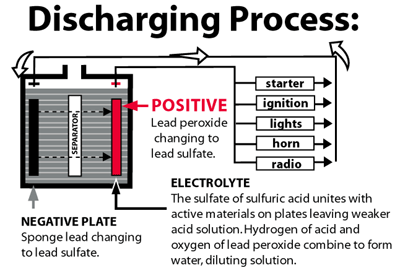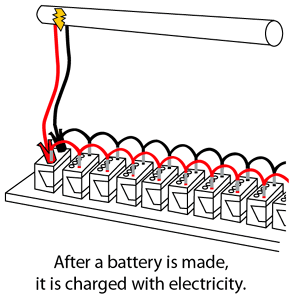A battery stores electricity for future use. It develops voltage from the chemical reaction produced when two unlike metals, such as the positive and negative plate materials, are immersed in the electrolyte, a solution of sulphuric acid and water. In a typical lead-acid battery, the voltage is approximately 2 volts per cell, for a total of 12 volts. Electricity flows from the battery as soon as there is a circuit between the positive and negative terminals. This happens when any load that needs electricity, such as the radio, is connected to the battery.

Most people don’t realize that a lead-acid battery operates in a constant process of charge and discharge. When a battery is connected to a load that needs electricity, such as the starter in your car, current flows from the battery. The battery begins to be discharged.
In the reverse process, a battery becomes charged when current flows back into it. This happens when you’re driving without any accessories and the alternator puts current back into the battery.
As a battery discharges, the lead plates become more chemically alike, the acid becomes weaker, and the voltage drops. Eventually, the battery is so discharged that it can no longer deliver electricity at a useful voltage.

You can recharge a discharged battery by feeding electrical current back into the battery. A full charge restores the chemical difference between the plates and leaves the battery ready to deliver its full power.
If the battery won’t start your car, you usually refer to it as “dead,” even though that’s not technically correct. A battery that’s merely discharged – from leaving your headlights on or from a faulty alternator — can usually be recharged to its full capacity. But a battery that’s at the end of its service life can’t be recharged enough to restore it to a useful power level. Then it truly is dead and must be replaced.
If the battery is discharged, not dead, you can jump-start it from another fully charged battery. About 30 minutes of driving should allow the alternator to return charge the battery (in such cases it is recommended that the battery be given a top-up charge at an auto servicing outlet so as to restore full charge). But if the alternator or another part of the electrical system in your car is damaged, they won’t be able to recharge your battery. So if your battery keeps discharging, before you replace it, have your electrical system checked. What looks like a bad battery could be an electrical system problem. If you have a bad component in the electrical system, it will keep draining a new battery, and you’ll be stranded again and again.
